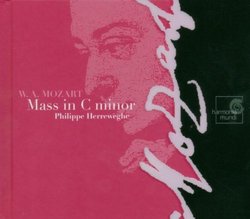| All Artists: Wolfgang Amadeus Mozart, Philippe Herreweghe, Orchestre des Champs-Élysées, Christiane Oelze, Jennifer Larmore, Scot Weir Title: Mozart: Mass in C minor, K. 427 (The Great) / Meistermusik, for male chorus - Herreweghe, Larmore, Kooy, Vallon Members Wishing: 0 Total Copies: 0 Label: Harmonia Mundi Fr. Original Release Date: 1/1/2006 Re-Release Date: 3/14/2006 Album Type: Import, Limited Edition Genre: Classical Styles: Opera & Classical Vocal, Chamber Music, Historical Periods, Classical (c.1770-1830) Number of Discs: 1 SwapaCD Credits: 1 UPC: 794881792221 |
Search - Wolfgang Amadeus Mozart, Philippe Herreweghe, Orchestre des Champs-Élysées :: Mozart: Mass in C minor, K. 427 (The Great) / Meistermusik, for male chorus - Herreweghe, Larmore, Kooy, Vallon
CD Details |
CD ReviewsThe "Great" Mass in C minor, K. 427 (Vienna 1783) Fareed Suheimat | Amman, Jordan | 10/11/2006 (5 out of 5 stars) ""It has rightly been said that this torso is the only work that stands between the B minor Mass of Bach and the D major Mass of Beethoven." Alfred Einstein
Mozart wrote this work during a period of intense contrapuntal study in response to the "learned" style of Handel and Bach, and apparently in thanksgiving for the recovery of his beloved Constanze from a serious illness she suffered just before their marriage in 1782. Constanze, according to legend, was also a soloist in the first performance. This period performance directed by Herreweghe is outstanding, and the two soprano soloists are particularly good. While not as overtly dramatic as Karajan's or Gardiner's, this set is none the worse for that. What is lost in extra intensity is more than made up for in beauty. This approach works especially well in the Qui Tollis, which can sometimes sound too hard driven and even pompous but here sounds very beautiful. The Quoniam is a highlight for me, showing Handelian grandeur and great nobility in the shape of the opening gambit by the first violins, which (according to Einstein) is related to the main idea of the final movement of the D major Piano Concerto K. 175 (try to hear Brendel in this concerto if you can, as he provides a very witty cadenza). This particular issue comes in a very attractive hard-cover booklet instead of a standard CD case, with a clear plastic cover slip for protection. In the booklet are excellent colour photographs and pictures including two full page portraits of J S Bach! (The excellent notes highlight the influence of Bach and Handel in this great work.) The recorded sound quality is outstanding. This is possibly the best recorded K. 427 currently available. Overall a remarkable issue." |


 Track Listings (13) - Disc #1
Track Listings (13) - Disc #1